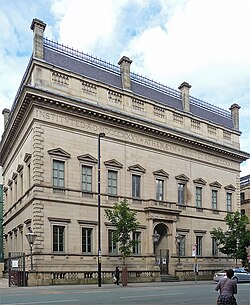Manchester Athenaeum
| Manchester Athenaeum | |
|---|---|
 Manchester Athenaeum is part of the art gallery | |
 | |
| General information | |
| Architectural style | ItalianPalazzostyle |
| Address | Princess Street,Manchester,England |
| Year(s) built | 1837 |
| Technical details | |
| Material | sandstoneashlar |
| Design and construction | |
| Architect(s) | SirCharles Barry |
| Designations | |
Listed Building– Grade II* | |
| Official name | The Athenaeum |
| Designated | 2 October 1974 |
| Reference no. | 1270889 |
| Other information | |
| Public transit access | St Peter's Square tram stop |
TheAthenaeumonPrincess StreetinManchester,England, now part ofManchester Art Gallery,was originally a club built for the Manchester Athenaeum, a society for the "advancement and diffusion of knowledge", in 1837. The society, founded in 1835, met in the adjacentRoyal Manchester Institutionuntil funds had been raised for the building. The society survived financial difficulties to become the centre for Manchester's literary life. It ceased operations in 1938.
SirCharles Barrydesigned the Athenaeum building in the Italianpalazzostyle, the first such building in the city.Manchester Corporationacquired the building in 1938.
In 2002, Manchester Art Gallery was extended byHopkins Architectsfollowing anarchitectural design competitionmanaged byRIBA Competitionsto take in the Athenaeum.[1]It is linked to the art gallery by a glassatrium.[2]The Athenaeum is a grade II*listed building.[3]
Society[edit]
The Manchester Athenaeum for the Advancement and Diffusion of Knowledge[4]was founded in 1835, withJames Heywoodas its first president.[5]It met initially at the Royal Manchester Institution until funds had been raised for its own building, which was completed in 1837. Their new premises had a newsroom on the ground floor, and a library, lecture hall and coffee room. Abilliardsroom and gymnasium were added later.[6]
Richard Cobdenwas instrumental in promoting education in the city and spoke at the opening.[7]He, along with a significant number of other members of theAnti-Corn Law League's Council, was an important figure in both instigating and developing the society during its early years. He described it as a "manufactory for working up the raw intelligence of the town".[8]
By 1838, there were over 1,000 members, each paying an annual subscription of 30shillings.[8]The club then hit upon and survived financial difficulties to become the centre for Manchester's literary life.[6]A report about the society in theSheffield Timesin 1847 noted that it catered for the "mental and moral improvement" of the intelligent among the middle-classes and that the shared pursuit of "rational amusement" was an aid to bridging the social gap between masters and men. That report, and thus the society, directly inspired two societies with similar goals inSheffield,confusingly both calling themselves theSheffield Athenaeum.[5]
The society was promoted as "an institution for the benefit of the tradesmen, commercial assistants and apprentices, professional students, clerks, of this very populous and flourishing town". It also emphasised its admission of women, although in practice until 1844 they had limited membership rights, being barred from full engagement in its activities and from its management.[9]Charles DickensandBenjamin Disraeliaddressed its membership in the 1840s.[7]
Manchester Corporation acquired the building in 1938,[10]when the society ceased operations.[6]
Architecture[edit]
SirCharles Barry,who designed the Royal Manchester Institution in theGreek Revival style,designed the Athenaeum in the Italian palazzo style, the first such building in the city.[10]
The building is constructed ofsandstoneashlarunder a slate roof on a rectangular plan and originally had two storeys and a basement. It has a symmetrical nine-windowfaçadewith raisedrusticatedquoinsat the corners and an inscribedfriezeunder a prominentmutuledcornice.The inscriptions on the frieze are, "INSTUTVTED MDCCCXXXV ATHENAEUM ERECTED MDCCCXXXVIII" and "FOR THE ADVANCEMENT AND DIFFVSION OF KNOWLEDGE". The building's interior was damaged by fire in 1874 and was remodelled and an attic floor was added behind a highbalustradedparapetwith four tall chimneys.[3]
A central entrance porch with acofferedbarrel-vaultedceiling is accessed by a flight of stone steps and hasDoriccolumnssupporting a frieze, moulded cornice and balustraded parapet. The first and second floors have tall two-lightcasement windowswith architraves, balustrades and pediments to the second floor.[3]
See also[edit]
- Grade II* listed buildings in Greater Manchester
- Listed buildings in Manchester-M1
- List of societies for education in Manchester
References[edit]
Notes
- ^Manchester Art Gallery,Royal Institute of British Architects,retrieved1 May2012
- ^Manchester Art Gallery Case Study(PDF),Royal Institute of British Architects,archived fromthe original(PDF)on 14 December 2013,retrieved2 May2012
- ^abcHistoric England,"The Athenaeum 81 Princess Street (1270889)",National Heritage List for England,retrieved1 May2012
- ^Milner 2013,p. 74
- ^abWhite, Alan (1990). "Class, culture and control: the Sheffield Athenaeum movement and the middle class 1847-64". In Wolff, Janet; Seed, John (eds.).The Culture of Capital: Art, Power and the Nineteenth-Century Middle Class.Manchester University Press. p. 88.ISBN978-0-71902-461-0.
- ^abcThe Athenaeum, Princess Street, Manchester, Greater Manchester,English Heritage,retrieved1 May2012
- ^abFrangopulo 1977,p. 104
- ^abPickering & Tyrell 2000,p. 226
- ^Gleadle 1998,p. 147
- ^abHartwell 2001,p. 90
Bibliography
- Frangopulo, Nicholas Joseph (1977),Tradition in action: the historical evolution of the Greater Manchester County,EP Publishing,ISBN0-7158-1203-3
- Gleadle, Kathryn (1998) [1995],The Early Feminists: Radical Unitarians and the Emergence of the Women's Rights Movement, 1831-51(Reprinted ed.), St Martin's Press,ISBN978-1-34926-582-4
- Hartwell, Clare (2001),Manchester,Pevsner Architectural Guides,Yale University Press,ISBN0-300-09666-6
- Milner, Stephen J. (2013), "Manufacturing the Renaissance: modern merchant princes and the origins of the Manchester Dante Society", in Wolff, Janet; Savage, Mike (eds.),Culture in Manchester: Institutions and Urban Change since 1850,Oxford University Press,ISBN978-1-52610-209-6
- Pickering, Paul; Tyrell, Alex (2000),The People's Bread: A History of the Anti-Corn Law League,Bloomsbury Publishing,ISBN978-0-56720-497-4





